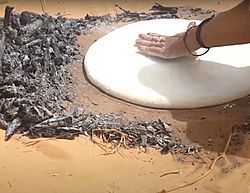Ash cake facts for kids

Woman preparing an ash cake over hot sand
|
|
| Alternative names | Ash bread; Fire cake |
|---|---|
| Type | Flatbread |
| Region or state | Yemen, Arabia |
| Main ingredients | Dough (flour, yeast, water, salt) |
Ash cake (also known as Ash bread; Fire cake) is a type of bread baked over a layer of heated stones or sand and covered-over in hot ashes, a practice still found principally in Arabian countries, especially among Bedouins.
Epiphanius (c. 310–403), in his work entitled On Weights and Measures, brings down an anecdote about the practice of baking ash cakes, and which, in Hebrew, Epiphanius calls ugoth (Hebrew: עֻגוֹת ʿugōṯ, modern meaning: cakes), adding that it is the bread described in Genesis 18:6, when Sarah, the wife of Abraham, was enjoined by her husband to knead three measures of fine meal and to bake cakes for the visiting angels.
When the bread (fine flour) has been kneaded and has afterward fermented, it is kneaded again. They bake this bread not in an oven but on a rock. Collecting smooth stones and piling them upon the ground, by means of much brushwood they heat them until they make of the smooth (stones) glowing embers. Then they remove the ashes from them, cover them with dough, and again spread the ashes over all the dough, spreading it out as one loaf, and hence it is called "hidden," because [it is] concealed in the ashes.
According to Epiphanius, the Hebrew name for this bread is derived, etymologically, from its manner of being baked as "bread that is hidden." Once the bread is baked, it is removed from the ashes, and the ashes brushed-off the bread before allowing it to cool.
Other methods of preparation
In northern Yemen, ash cakes were called ğamrī (Arabic: جَمْرِي), typically made thick, and baked directly over coals kept in a special vessel made of basalt-stone. In Arabia, ash cake is served with a treacle of date syrup (dibs) and with clarified butter (samne).
In North America, ash cakes were primarily made by using cornmeal. Indigenous peoples of the Americas using ground corn for cooking are credited with teaching Europeans how to make ash cakes. The manner of preparation varied, although one popular method was to brush aside the hot ashes, lay a large collard green leaf upon the hot earth or cast-iron oven, upon which was poured a batter of cornmeal, and over which was laid another collard green leaf, and the hot ashes piled thereon.
In Europe, ash cakes were made into a small, round and flat loaf, usually consisting of a little wheat and sometimes rye, baked under an inverted iron pan over which the ashes of the fire were heaped. This was almost exclusively the bread of the peasants. In French, this type of bread was called fougasse.
Classic literature
In classic Hebrew literature, the words עֻגַת רְצָפִים in 1 Kings 19:6 are explained by a consortium of commentators (Rashi, Radak, Joseph Kara, Ralbag, Malbim, among others) as having the connotation of a cake baked on hot stones, coals or cinders. The ash-cake described by A. Mizrachi (Arabic: ğamrī) is also baked directly over coals and thought to be a delicacy in South-Arabia.

